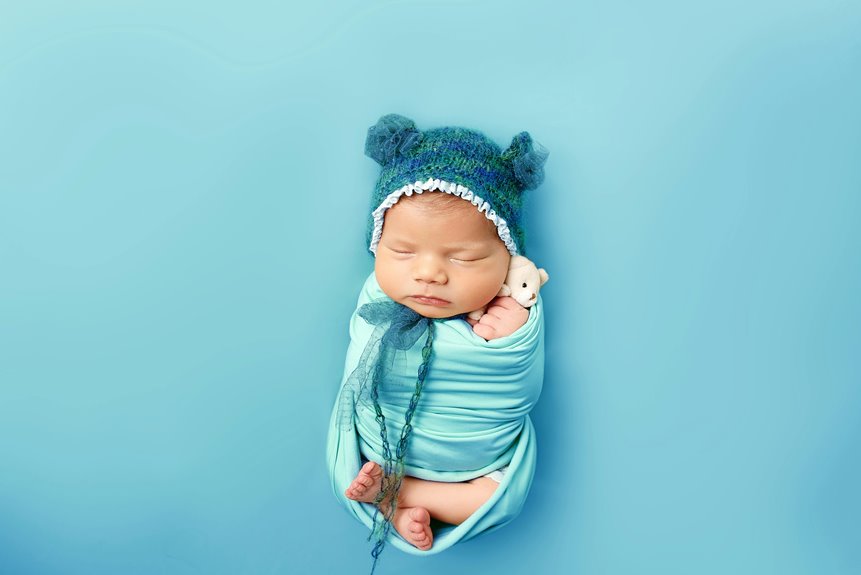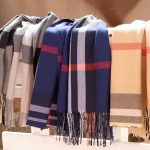When choosing baby swaddle gauze fabric by the yard, focus on soft, breathable, and lightweight cotton to keep your baby comfy and safe. Make sure it’s organic or OEKO-TEX certified to avoid irritants like formaldehyde and heavy metals. Check the fabric’s width and add extra for seams and shrinkage. Cotton gauze resists wear and washes well, ideal for sensitive skin. If you want to craft perfect, cozy swaddles, exploring fabric types and practical tips can help you decide.
Table of Contents
Key Takeaways
- Select 100% organic cotton gauze for optimal softness, breathability, and safety against toxins and allergens.
- Choose a loosely woven, lightweight fabric to ensure proper airflow and prevent overheating.
- Verify certifications like OEKO-TEX or GOTS to confirm the fabric is free from harmful chemicals and heavy metals.
- Measure fabric length and width accurately, adding extra for hems, seams, shrinkage, and pattern matching.
- Prefer tightly woven gauze that balances durability with stretch for snug, comfortable swaddling without tearing.
Understanding the Importance of Fabric Choice for Baby Swaddles
When you choose the right fabric for your baby’s swaddle, you guarantee comfort and safety during sleep. The fabric directly affects your baby’s temperature regulation, breathability, and skin sensitivity.
If the material is too heavy or non-breathable, your little one might overheat, causing discomfort or even risk. On the other hand, rough or irritating fabrics can lead to skin rashes or allergic reactions.
You want a fabric that gently hugs your baby without restricting movement or causing irritation. Additionally, the durability and ease of cleaning matter since swaddles see frequent use.
Key Characteristics of Gauze Fabric for Swaddling
When choosing gauze fabric for swaddling, you’ll want to focus on breathability and softness to keep your baby comfortable.
It’s also important to reflect on durability and stretch, so the fabric holds up through lots of use and wraps snugly.
Let’s explore how these features make gauze ideal for swaddling.
Breathability and Softness
Breathability and softness are essential qualities you should look for in gauze fabric for swaddling your baby.
Breathable fabric allows air to circulate, preventing overheating and reducing the risk of discomfort or skin irritation. When you choose gauze with excellent airflow, your baby stays cool and calm, promoting better sleep.
Softness matters just as much. You want fabric that feels gentle against your baby’s sensitive skin, avoiding any rough textures that could cause redness or rashes. High-quality gauze often has a light, airy weave that feels plush yet thin.
When you pick a fabric that balances breathability and softness, you make certain your baby stays cozy and comfortable. This thoughtful choice helps create a safe, soothing swaddling experience every time.
Durability and Stretch
Although softness and airflow are essential, you’ll also want gauze fabric that holds up well and stretches just right.
Durability guarantees your swaddle won’t wear out after multiple washes or lose its shape. Look for tightly woven gauze that resists tearing but remains lightweight.
Stretch is equally important—it helps the fabric snugly wrap your baby without being too tight or restrictive. A bit of natural elasticity allows for easy wrapping and adjusts as your baby moves.
Avoid fabrics that feel stiff or overly loose, as they won’t provide secure swaddling. By choosing gauze with the right balance of durability and stretch, you guarantee comfort and safety for your little one while getting the most value from your fabric purchase.
Comparing Cotton Gauze Versus Other Fabric Types
When choosing swaddle fabric, you’ll want to weigh how cotton gauze stacks up against other materials in breathability and softness.
You’ll also need to evaluate durability and how easily each fabric handles washing.
Let’s compare these key factors to help you make the best choice for your baby.
Breathability and Softness
Since your baby’s comfort depends heavily on the fabric’s feel and airflow, you’ll want to focus on materials that are both soft and breathable.
Cotton gauze stands out because it’s lightweight and allows excellent air circulation, reducing the risk of overheating. Compared to synthetic fabrics, cotton feels gentler on delicate skin and wicks moisture effectively.
When choosing your swaddle fabric, consider these factors:
- Breathability – Cotton gauze lets air pass freely, keeping baby cool.
- Softness – Its natural fibers feel smooth, preventing irritation.
- Moisture-wicking – Cotton absorbs sweat, helping maintain dryness.
- Hypoallergenic – It’s less likely to cause allergies than many synthetics.
Opting for cotton gauze guarantees your baby stays comfy, cozy, and safe during swaddling.
Durability and Care
Because you’ll be washing swaddle fabrics frequently, durability and ease of care are essential factors to take into account.
Cotton gauze stands out for its ability to withstand repeated washing without losing softness or shape. Unlike some synthetic blends that may pill or degrade over time, cotton gauze becomes even more comfortable with each wash.
It’s also naturally breathable, which helps reduce the risk of mildew during laundering. While silk or linen gauze might offer unique textures, they often require delicate handling and special detergents, making them less practical for everyday use.
When you choose cotton gauze, you get a fabric that’s both resilient and low-maintenance—perfect for busy parents who want a swaddle that lasts and stays cozy with minimal effort.
Evaluating Breathability and Softness for Infant Comfort
How can you guarantee your baby stays comfortable while swaddled? You focus on breathability and softness—two critical factors for infant comfort. Choosing gauze fabric that allows air circulation prevents overheating, keeping your baby cozy yet cool.
To evaluate breathability and softness, consider:
- Fabric Weave: Looser weaves enhance airflow.
- Material Type: Organic cotton gauze feels soft and breathable.
- Texture: Run your fingers over the fabric to confirm it’s smooth, not scratchy.
- Weight: Lightweight gauze fabrics promote better ventilation.
Assessing Durability and Washability in Swaddle Fabrics
Breathability and softness keep your baby comfortable, but durability and washability guarantee the swaddle lasts through countless washes and daily use.
When choosing gauze fabric, look for tightly woven fibers that resist wear and tear without sacrificing softness. Durable fabrics maintain their shape and texture after repeated laundering, so check for materials labeled as machine washable and easy to care for.
You’ll want a fabric that doesn’t shrink or fade quickly, making certain your swaddle stays safe and attractive. Also, avoid materials that require special washing instructions, as convenience matters when caring for baby items.
Considering Fabric Weight and Thickness for Different Seasons
When selecting swaddle gauze fabric, you should consider the weight and thickness to match the season. Choosing the right fabric guarantees your baby stays comfortable year-round. Here’s how to decide:
- Lightweight for Summer: Opt for thin, breathable gauze to keep your baby cool and prevent overheating.
- Medium Weight for Spring/Fall: Choose a slightly thicker fabric to provide warmth without causing sweating.
- Heavyweight for Winter: Pick thicker, denser gauze to offer extra insulation during cold months.
- Layering Option: Select lighter gauze for layering in colder seasons, allowing you to adjust warmth as needed.
Identifying Safe and Non-Toxic Fabric Treatments
Ensuring your baby’s swaddle gauze fabric is treated with safe and non-toxic substances is essential for their health and comfort. Harmful chemicals can irritate delicate skin or cause allergic reactions. When choosing fabric, look for certifications like OEKO-TEX or GOTS, which guarantee the absence of toxic substances. Avoid fabrics treated with formaldehyde, azo dyes, or heavy metals. Instead, opt for naturally dyed or untreated gauze fabric to keep your baby safe.
| Treatment Type | Safety Indicator |
|---|---|
| Formaldehyde | Avoid – irritant, toxic |
| Azo Dyes | Avoid – potential allergen |
| Heavy Metals | Avoid – harmful contaminants |
| OEKO-TEX Certified | Safe – tested for toxins |
| GOTS Certified | Safe – organic & non-toxic |
Tips for Measuring and Buying Gauze Fabric by the Yard
Choosing the right amount of gauze fabric can save you time and money, so start by measuring your swaddle dimensions carefully.
Here are some tips to help you buy the perfect yardage:
- Measure the length and width of the swaddle you want to make, then add a few extra inches for hems and seams.
- Check the width of the fabric roll; this affects how much length you’ll need.
- Consider buying a little extra to account for pattern matching or fabric shrinkage after washing.
- Round up your total measurement to the nearest half or full yard to simplify your purchase.
Following these steps guarantees you get enough fabric without overspending or running short during your project.
Creative Ideas for Using Gauze Fabric in Baby Swaddle Projects
Although gauze fabric is often prized for its softness and breathability, it also offers plenty of creative possibilities for baby swaddle projects.
You can design personalized swaddles by dyeing the fabric with safe, natural colors or adding fabric paint patterns. Try layering multiple gauze sheets for extra warmth or creating lightweight blankets perfect for warmer months.
Consider sewing pockets or attaching small fabric tags for sensory stimulation. You can even craft matching accessories like burp cloths, hats, or bibs using leftover gauze.
If you enjoy embroidery, adding simple stitched designs can make your swaddle unique and charming.
With gauze’s flexibility, you’re free to experiment with shapes and sizes, ensuring your baby stays cozy and stylish in a handmade swaddle tailored just for them.
Frequently Asked Questions
Can Gauze Fabric Be Used for Other Baby Accessories Besides Swaddles?
You can definitely use gauze fabric for other baby accessories like burp cloths, lightweight blankets, and bibs. Its softness and breathability make it perfect for gentle, everyday baby items you’ll love creating.
How Do I Care for Gauze Fabric to Prevent Shrinking?
You want to wash gently, dry slowly, and store loosely. Always use cold water, avoid harsh detergents, and air dry or tumble dry on low. These steps will help you keep gauze fabric soft and shrink-free.
Is Gauze Fabric Suitable for Newborns With Sensitive Skin?
Yes, gauze fabric is perfect for newborns with sensitive skin because it’s soft, breathable, and gentle. Just make sure to choose 100% cotton gauze to avoid irritation and always wash it with mild detergent before use.
Where Can I Buy Gauze Fabric by the Yard Online?
You can buy gauze fabric by the yard online at fabric stores like Joann, Etsy, or Amazon. They offer various colors and qualities, so you’ll find soft, breathable options perfect for your baby’s needs.
Can Gauze Fabric Be Dyed or Printed for Custom Swaddles?
Yes, you can dye or print gauze fabric to create custom swaddles. Just remember, gauze is delicate, so use gentle dyes and printing methods to keep it soft and breathable for your baby’s comfort.
- Velvet Fabric in Arabic: Terminology & Cultural Context - June 22, 2025
- Best Fabric Paint for Velvet: Product Recommendations & Application - June 22, 2025
- Velvet Upholstery Fabric Content: Typical Fiber Blends & Performance - June 22, 2025







